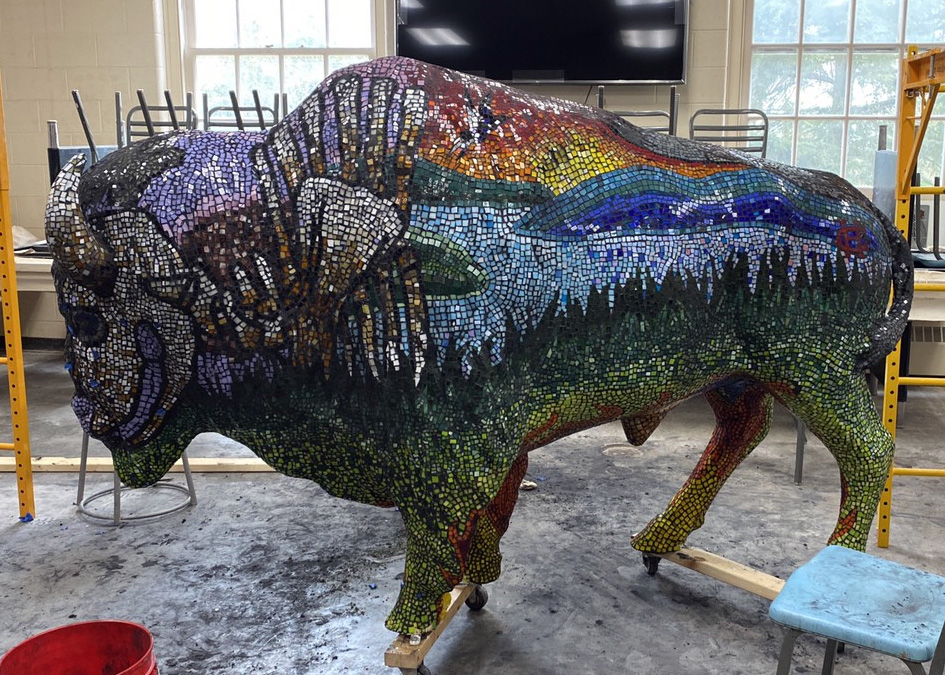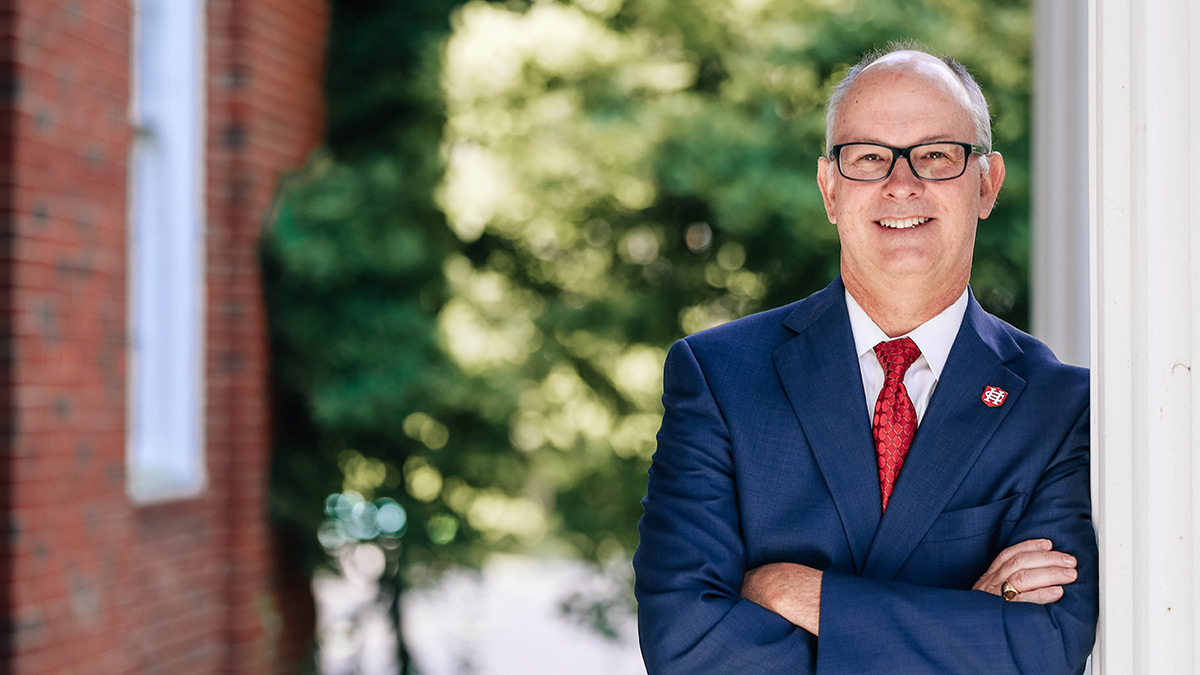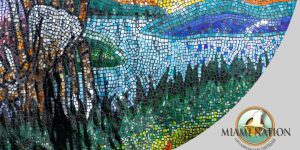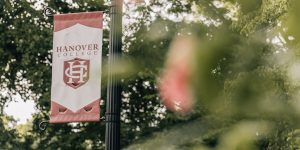Environmental art students assemble homage to Miami Tribe

A unique recycling project will serve as a public tribute to the Miami Nation of Indians through the efforts of students in Hanover’s fall-term environmental sculpture course.
“Sunder” – or broken apart – is a revisualization of a large fiberglass bison that was originally presented to the College by Duke Energy more than six years ago. The bison, which stands eight-and-one-half-feet long and five-feet tall, has been meticulously adorned with small colorful stained-glass tiles that blend to portray imagery to honor the Miami Tribe, beauty of the river valley and historical importance of the bison.

“There is a very complex story woven into the visual elements of this piece,” stated Visiting Assistant Professor Mathew Gaddie, who guided the 16-week project. “The students were able to mesh it all into something both beautiful and thought-provoking.”
Students working on the project included Wren Abney ’26, Elizabeth Bolinger ’23, Preston Bradley ’26, Katelyn Enginger ’25, Colton Fisher ’24, Maddie Gaebel ’24, Elizabeth Graves ’25, Arizona Harvey ’23, Kennedi Roehrig ’24, Callie Wilder ’23 and Grant Willis ’23. Abney and Enginger were tasked with organizing design efforts for the group.
“The first few classes we worked together to research the Miami Tribe and generate design ideas,” noted Abney. “We all created our own individual interpretations of the design and then we sort of voted on our favorite elements of every design.”
The vibrant final imagery features multiple symbolic depictions, including the winding Ohio River, sunrise and sunset, grass, fire and smoke, soaring crane, crawling turtle, skeletal structure of the animal and Oklahoma’s Gloss Mountains.
Abney added, “The Miami Tribe of Indiana used [the Point] as a lookout for enemies and now it is a significant place for our community. I thought it tied the whole concept together really well and it was visually appealing. Katelyn worked on the other side and illustrated the Gloss Mountains, which is a significant place for the Miami Tribe of Oklahoma, and it basically connects the two tribes together.”

In addition to three weeks of design, the students’ efforts also included countless hours of sanding, applying marine-grade primer, tedious cutting and placement of stained-glass and ceramic tiles and, eventually, campus site selection. Nearly 6,000 pieces of tile were hand-cut for the project. The volume of small tiles, measuring just one-quarter inch by one-quarter inch, was essential for covering the contours of the bison and bringing the design to life.
“We estimate that the students collectively put in 1,600 hours of just glass work,” exclaimed Gaddie. “Their commitment to craftsmanship was matched only by their support of each other. Every student found a way to use their particular skill sets to contribute.”
The substantial array of colorful glass and tiles were donated by the family of the late Professor Emeritus Jim Shaffstall, who served as professor of art at Hanover from 1967-99, and Rick Lostutter, current associate professor of art and department chair.
“The bulk of the credit [for the project] really should go to Rick,” said Gaddie. “The idea to combine the bison and the recycled glass was always his dream. He was also the one who suggested we try to use the story of the Miami Tribe as a starting point.”
Once a blank slate, the bison was originally presented to the College in 2016 as part of a statewide celebration of Indiana’s 200th birthday. “Reggie,” as dubbed by students at the time, was painted in support of the Indiana Association of United Ways’ Bison-tennial Art Project, which placed at least one bison in each of Indiana’s 92 counties.
Malik Hairston ‘17 and Morgan Livinghouse ’18 led the original student project. The initial artwork showed a view from the Point, along with the Parker Auditorium cupola, in shades of blue on one side. The opposite side featured a white Hanover logo on a red field. The head was covered in faux black fur to represent the Hanover panther.
Set to brilliantly “graze” in front of the Science Center, the bison’s revisualization ultimately provided the students with much more than a group task.
“I had a much different plan for this class, but as it all unfolded, I could see how much the [students] were getting out of this project,” reflected Gaddie. “They learned how to visually represent ideas from research. They learned how to work together and work with outside administrative bodies. They made compromises when needed, stood their ground and formulated arguments when necessary. I am hopeful that this will open more doors for similar projects down the road.”




